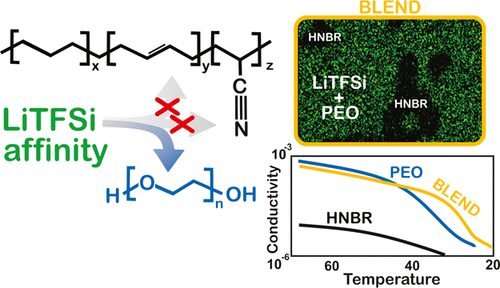当前位置:
X-MOL 学术
›
ACS Appl. Polym. Mater.
›
论文详情
Our official English website, www.x-mol.net, welcomes your
feedback! (Note: you will need to create a separate account there.)
Effect of Li+ Affinity on Ionic Conductivities in Melt-Blended Nitrile Rubber/Polyether
ACS Applied Polymer Materials ( IF 4.4 ) Pub Date : 2020-10-13 , DOI: 10.1021/acsapm.0c00827 Léa Caradant 1 , David Lepage 1 , Paul Nicolle 1 , Arnaud Prébé 1 , David Aymé-Perrot 2 , Mickaël Dollé 1
ACS Applied Polymer Materials ( IF 4.4 ) Pub Date : 2020-10-13 , DOI: 10.1021/acsapm.0c00827 Léa Caradant 1 , David Lepage 1 , Paul Nicolle 1 , Arnaud Prébé 1 , David Aymé-Perrot 2 , Mickaël Dollé 1
Affiliation

|
Substituting flammable liquid electrolytes with solid polymer electrolytes (SPEs) presents a serious challenge in improving the safety of lithium-ion batteries. Even though SPEs are a safer choice, their ionic transport properties are still lower than those of their liquid counterparts (<10–4 S·cm–1 at room temperature). Here, we report the preparation of a blend of polymers used as SPEs in lithium-ion batteries. Composed of an elastomer, hydrogenated nitrile butadiene rubber (HNBR), and poly(ethylene oxide) (PEO), this blend combines the high conductivity of PEO and the stable properties of HNBR and shows better flexibility than a pristine PEO SPE. It is worth noting that the addition of HNBR, coupled with the intrinsic LiTFSI salt concentration, also reduces the crystallinity and melting temperature of typical PEO-LiTFSI SPEs; this also explains the higher ionic conductivity at low temperature (1.18 × 10–4 S·cm–1 at 40 °C). Given these initial results, we may conclude that this polymer blend is a promising candidate as an SPE for all solid-state lithium-ion batteries.
中文翻译:

Li +亲和力对熔融共混丁腈橡胶/聚醚中离子电导率的影响
用固态聚合物电解质(SPE)替代易燃液体电解质对提高锂离子电池的安全性提出了严峻的挑战。尽管固相萃取是较安全的选择,但其离子迁移性能仍低于其液态离子迁移性能(<10 –4 S·cm –1在室温下)。在这里,我们报告了锂离子电池中用作SPE的聚合物共混物的制备。该混合物由弹性体,氢化丁腈橡胶(HNBR)和聚环氧乙烷(PEO)组成,结合了PEO的高导电性和HNBR的稳定性能,并且比原始的PEO SPE具有更好的柔韧性。值得注意的是,加入HNBR加上固有的LiTFSI盐浓度,也会降低典型PEO-LiTFSI SPE的结晶度和熔融温度。这也解释了低温下较高的离子电导率(40°C时为1.18×10 –4 S·cm –1)。考虑到这些初步结果,我们可以得出结论,这种聚合物共混物是所有固态锂离子电池SPE的有前途的候选者。
更新日期:2020-11-13
中文翻译:

Li +亲和力对熔融共混丁腈橡胶/聚醚中离子电导率的影响
用固态聚合物电解质(SPE)替代易燃液体电解质对提高锂离子电池的安全性提出了严峻的挑战。尽管固相萃取是较安全的选择,但其离子迁移性能仍低于其液态离子迁移性能(<10 –4 S·cm –1在室温下)。在这里,我们报告了锂离子电池中用作SPE的聚合物共混物的制备。该混合物由弹性体,氢化丁腈橡胶(HNBR)和聚环氧乙烷(PEO)组成,结合了PEO的高导电性和HNBR的稳定性能,并且比原始的PEO SPE具有更好的柔韧性。值得注意的是,加入HNBR加上固有的LiTFSI盐浓度,也会降低典型PEO-LiTFSI SPE的结晶度和熔融温度。这也解释了低温下较高的离子电导率(40°C时为1.18×10 –4 S·cm –1)。考虑到这些初步结果,我们可以得出结论,这种聚合物共混物是所有固态锂离子电池SPE的有前途的候选者。









































 京公网安备 11010802027423号
京公网安备 11010802027423号